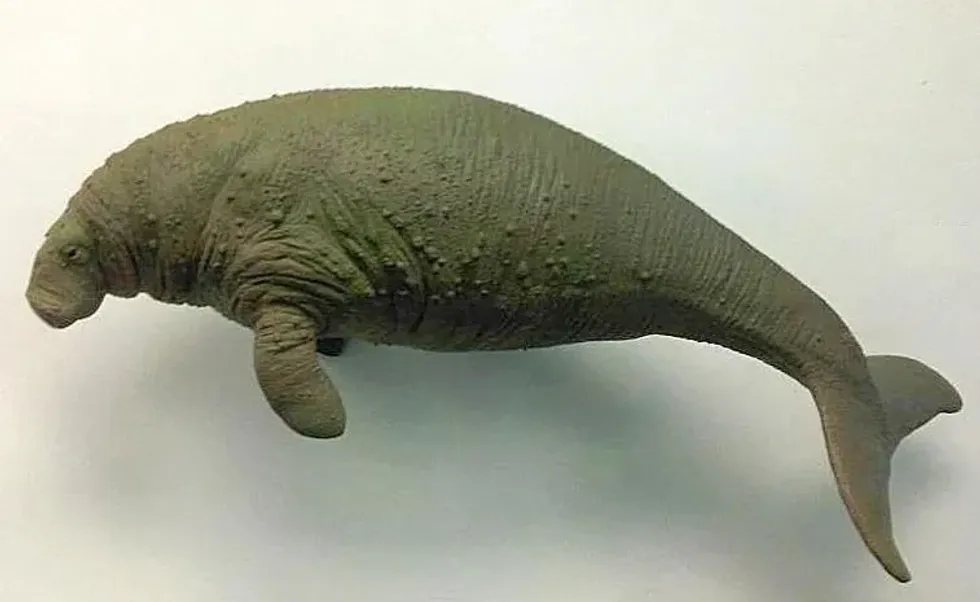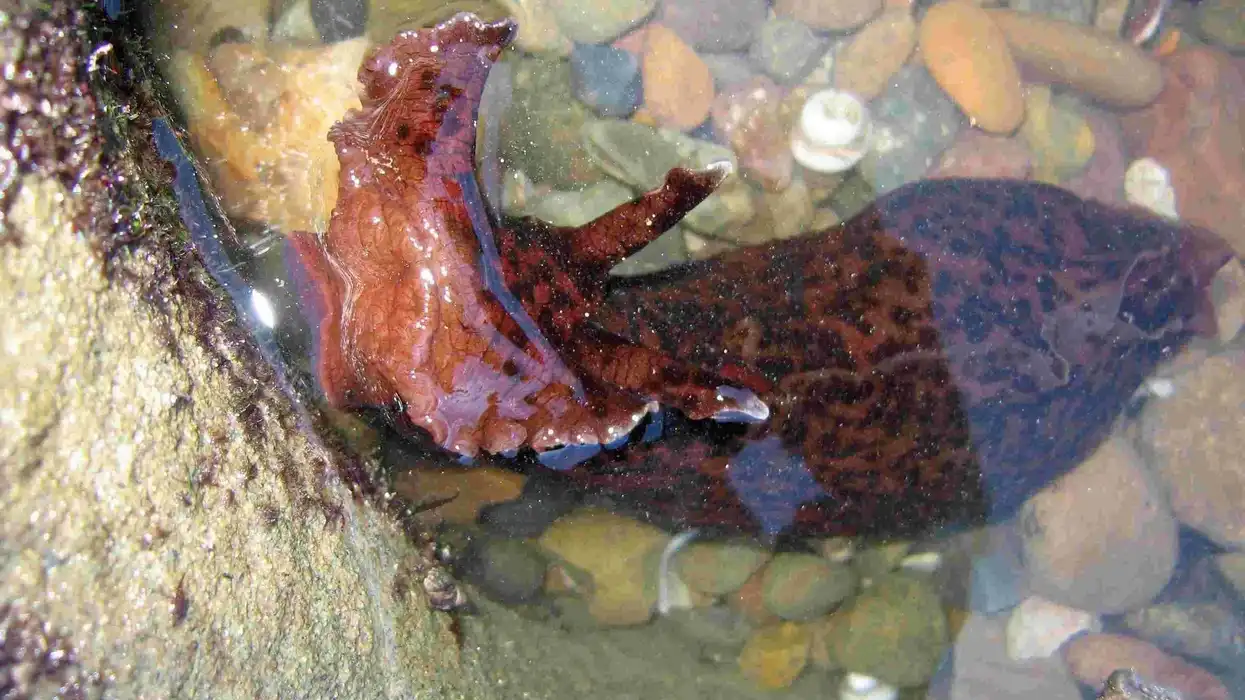The Steller’s sea cow (Hydrodamalis gigas) is an extinct marine mammal. These mammals became officially Extinct, just 27 years after their discovery.
The Steller’s sea cow was first discovered in the region of Commander Islands in the Bering Sea between Alaska and Russia. Steller's sea cows are often referred to as sirenians.
During the Pleistocene epoch, the sea cow may be found in other arctic regions too. The animal was first witnessed by George Wilhelm Steller in 1741, till then this species was unknown to science. One of the first Steller's sea cow sightings was by Wilhelm Steller during the Vitus Bering’s Great Northern Expedition.
Much of what we know about this sea cow comes from Steller's observation on the island and it is documented in his book 'On The Beasts Of Sea' which was published posthumously. Steller's sea cows were a slow-moving mammal that could be caught easily.
They were hunted for their meat, fat, and hide. Steller's sea cows had a thick layer of blubber due to which it couldn't submerge itself in shallow water.
Steller's sea cow distribution was historically concentrated around Bering Island and spread from Mexico to Japan in the Pacific Ocean. Steller’s sea cows had black or brownish colored skin, which could easily be pockmarked and rough to touch.
These animals had white bristles on their upper lip and keratinous plates within the mouth for chewing (in place of teeth). The creature lived in shallow waters and fed on kelp.
You may also check out blue whale facts and West Indian manatee facts and know more about our animal kingdom.
Steller's Sea Cow Interesting Facts
What type of animal is a Steller's sea cow?
Steller’s sea cows were a type of marine mammal. Sirenians were giant in size and had no real teeth. Unfortunately, due to their slow-moving speed, the animal was hunted regularly and became extinct very soon after their discovery. Steller’s sea cows are believed to be closely related to the manatee species.
What class of animal does a Steller's sea cow belong to?
Steller’s sea cows were an marine mammal found in the Pacific Ocean, primarily around the Bering Sea. It is a long-extinct creature that was hunted for its meat, hide and fat.
It is believed that the Hydrodamalis gigas (Steller's sea cow) became Extinct because these animals used to live around the regions, that were used by hunters who moved between Russia and North America.
How many Steller's sea cows are there in the world?
There are no Steller's sea cows in the world now. Steller’s sea cow Extinct status was determined after only 27 years of their discovery. The conservation status confirms it underwent Extinction in the 18th century. Their historical habitat was believed to be around the Bering Island.
Where does a Steller's sea cow live?
Steller’s sea cows were found in the northern Arctic region of the Commander’s island in the Bering sea between Russia and Alaska. They may have been found in more regions during the Pleistocene epoch.
Due to their thick blubber, they could adapt well to the tundra zone of the Arctic circle. They preferred living in shallow waters near their primary food source, kelp.
What is a Steller's sea cow's habitat?
Steller’s sea cow habitat was believed to in the shallow sea waters around the Commander Islands, which is present in Copper island and Bering island. During the Pleistocene era, Steller’s sea cows habitat was located much further into the Arctic and Pacific oceans which spanned from Japan to Mexico.
Who do Steller's sea cows live with?
The Steller’s sea cow was known as a monogamous creature who lived in shallow water bodies. This species lived in small family pods.
They were known to be protective of their younger ones. They would place the young ones in the safest position in the middle of the herd. These animals had a family-oriented nature and parental instincts for new calves.
How long does a Steller's sea cow live?
Stellar sea cows were thought to live for 50 to 80 years. But due to constant hunting, the animal became extinct in a very short period of time. This species has already undergone extinction in the year 1768.
How do they reproduce?
Female Steller’s sea cows, as observed by Georg Stellar, have only one set of mammary glands. The female sea cows were said to give birth to one offspring every breeding season. However, their gestation periods would last around one year.
Their mating season would be in early spring. The mating took place underwater. Mr. Steller observed that the male sea cow would hold the females with their front flippers during the mating period.
What is their conservation status?
The conservation status of the Steller’s sea cows has been labelled as Extinct since 1768 due to excessive hunting. These beautiful animals were hunted very frequently because people thought their skin, hide and meat was valuable.
By 1887 it was estimated (by Stejneger) that there may have been fewer than 1,500 individuals in the seas at the time of Steller’s discovery.
In 1963, there was a publication regarding the possible sighting of this marine mammal by the official journal of the Academy of Science of the USSR. But these reports were unfortunately unconfirmed.
Steller's Sea Cow Fun Facts
What do Steller's sea cows look like?
Steller’s sea cows were one of the largest mammals living in the sea at the time, and they are believed to look very similar to a manatee. They were believed to be able to grow to the length of 314-354 in (8-9 m).
These animals would weigh up to 17600 lb (7983 kg). The thick fat layer under their skin made them buoyant, which means they could not submerge themselves in water.
Steller’s sea cow skeleton analysis suggests that the sea cow’s head was small with a broad and large upper lip. This extends beyond the lower jaw.
The sea cow had a snout that let them hold their food better. Steller’s sea cows tails were fork-shaped, in a very similar way to the dugongs and whales.

*Please note this image is not of the Steller's sea cow, if you have an image of the Steller's sea cow, we'd love to hear from you at hello@kidadl.com.
How cute are they?
The extinct Steller’s sea cow would have been quite a scary or intimidating animal because of their humongous size. But these slow-moving mammals would be cute to look at too, especially for fans of other sea cows and manatees.
These animals do have strange faces, and bigger bodies than some other mammals. Unfortunately, we don't have the real animal to check how cute they would be, but it's imagined that they were adorable in their own way.
How do they communicate?
Steller’s sea cows were known to communicate with sighs and snorting sounds. Apart from these, there are no recordings of other possible sounds or methods of communication.
How big is a Steller's sea cow?
The Steller’s sea cow was definitely a large animal, with a measurement of 312-360 in (26-30 ft), which makes them as big as a blue whale.
How fast can a Steller's sea cow swim?
Steller’s sea cows weren't fast swimmers at all, which unfortunately was one of the reasons they were hunted so easily. Their slow swimming speed made it almost impossible for them to escape from hunters, leading to their eventual Extinction.
How much does a Steller's sea cow weigh?
There are some discussions about Steller’s actual weight. Scientists are not sure exactly how much they weighs, but are able to give an estimate.
Georg Steller recorded that one sea cow was 4.4 short ton (3991 kg), and the other was 26.8 short ton (24312 kg). The actual value could be somewhere in the middle. Experts say Steller's sea cows range of weight must have been 17600 lb (7983 kg).
What are the male and female names of the species?
This species did not survive long enough to be studied, and names for the male and female sea were never given.
What would you call a baby Steller's sea cow?
Baby Steller’s sea cows had no specific name, and were known as young Steller's sea cows.
What do they eat?
Steller’s sea cows were grazers and ate kelp as their primary source of food. These sea cows would lift their heads for a few minutes from the water and then return back to grazing. They ate seagrasses, algae, flowers, and kelp.
Were they dangerous?
Steller’s sea cows were not at all dangerous. These sea cows only made sure that their younger ones were protected. These animals were gregarious, family-loving creatures, much like elephants and whales.
Would they make a good pet?
Steller’s sea cows would have made a good pet, only if you had a proper place with shallow waters for their habitat and adequate quantities of sea grasses for them to graze on. But unfortunately, these sea cows have undergone extinction due to excessive hunting.
They were gentle animals that moved slowly and spent most of their time grazing on seagrasses.
Did you know...
Steller’s sea cows meat was described as palatable and similar to corned beef. It was said to be redder, tougher, and needed a longer cooking time.
The meat didn't need curing as the animals body had enough salt already, and therefore it lasted longer. The fat from Steller’s sea cows could be used as odorless lamp oil and for cooking.
It tasted like almond oil, and the crew of St Peter would drink it in a cup. Humans also used to drink the sweet thick milk of the female Steller’s sea cow or make butter out of it.
The thick hide could be used to make belts, shoes, clothing, and large skin boats. The Steller’s sea cow belongs to the same family as the dugong and manatees.
This species belongs to the order of Sirenia. As a matter of fact, Steller’s sea cows and manatee are believed to be closely related.
When a comparison of Steller’s sea cow vs manatees is undertaken, it is easy to see that the sea cow is the winner due to its sheer size and monstrosity. One sea cow would feed a ship full of men for 30 days.
Another theory for Steller’s sea cow Extinct status is that the islanders also hunted for the sea otters. This almost drove the sea otters to Extinction too.
These otters hunted the sea urchins, and due to their predators vanishing, the number of sea urchins increased tenfold. The sea urchins ate all the sea kelp, which may have led to food scarcity for the sea cows who would also eat kelp and seagrasses.
They reproduced once a year, and only bore one offspring. This birthing rate could never keep up with the decline in their numbers due to hunting, and therefore they went Extinct in a short period of 30 years.
The pallas picture is the famous drawing of the Stellar sea cow which was sketched from a complete specimen. The Steller’s sea cow has a very dense cortical bone from which knife handles and decorative articles were made.
Did Steller's sea cows make milk?
Yes, female Steller’s sea cows were used to make milk, and the crew of St. Peter drank the sweet and thick milk or made butter from it. The crew also drank the fat of this animal in cups, since it tasted like almond oil.
How many years after its discovery was the Steller's sea cow hunted into extinction?
Steller’s sea cows went Extinct just 30 years after they were discovered in 1741 by Georg Steller.
Here at Kidadl, we have carefully created lots of interesting family-friendly animal facts for everyone to discover! Learn more about some other mammals including harbor seal, or harp seal.
You can even occupy yourself at home by drawing one of our Steller's Sea Cow coloring pages.










